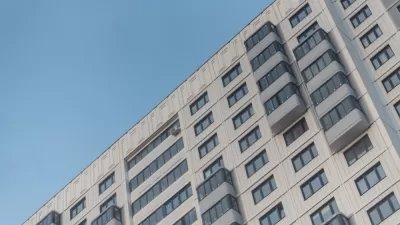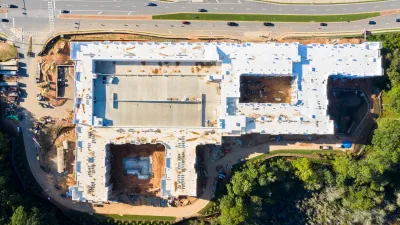A "white supremacist" law that blocks public housing in the state is up for repeal—again.

California leaders hope that in 2020, voters will agree to remove a barrier to public housing construction that has been enshrined in state law for 70 years.
That barrier is Article 34 of the California Constitution, which triggers a popular vote before public housing is built—a requirement unique to California. In a feature for the Los Angeles Times, Liam Dillon details how the amendment has not only diminished California's supply of affordable housing over the decades, but also hindered desegregation efforts throughout the state; shaped policy and finance around housing development; and led to a U.S. Supreme Court ruling that government could legally discriminate against poor people.
State Senator Ben Allen and Los Angeles Mayor Garcetti are among the leaders now pushing to abandon Article 34—calling the rule "anachronistic" and "white supremacist," respectively. If the measure appears on the ballot, it would mark the fourth time voters have been asked to repeal the law since it was first approved in 1950.
So far, it's never come close. But lawmakers hope that 2020 will be different. The last few years have seen voters support multiple tax increases and bond measures to fund affordable housing—and become increasingly likely to say yes to housing subject to their approval.
FULL STORY: A dark side to the California dream: How the state Constitution makes affordable housing hard to build

Planetizen Federal Action Tracker
A weekly monitor of how Trump’s orders and actions are impacting planners and planning in America.

Chicago’s Ghost Rails
Just beneath the surface of the modern city lie the remnants of its expansive early 20th-century streetcar system.

San Antonio and Austin are Fusing Into one Massive Megaregion
The region spanning the two central Texas cities is growing fast, posing challenges for local infrastructure and water supplies.

Since Zion's Shuttles Went Electric “The Smog is Gone”
Visitors to Zion National Park can enjoy the canyon via the nation’s first fully electric park shuttle system.

Trump Distributing DOT Safety Funds at 1/10 Rate of Biden
Funds for Safe Streets and other transportation safety and equity programs are being held up by administrative reviews and conflicts with the Trump administration’s priorities.

German Cities Subsidize Taxis for Women Amid Wave of Violence
Free or low-cost taxi rides can help women navigate cities more safely, but critics say the programs don't address the root causes of violence against women.
Urban Design for Planners 1: Software Tools
This six-course series explores essential urban design concepts using open source software and equips planners with the tools they need to participate fully in the urban design process.
Planning for Universal Design
Learn the tools for implementing Universal Design in planning regulations.
planning NEXT
Appalachian Highlands Housing Partners
Mpact (founded as Rail~Volution)
City of Camden Redevelopment Agency
City of Astoria
City of Portland
City of Laramie





























